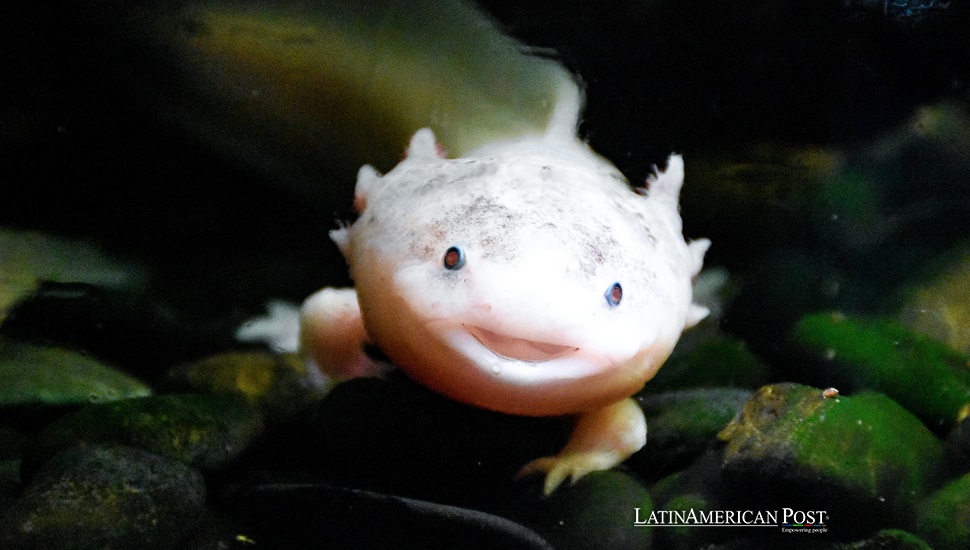Mexico’s Fight to Save Axolotls from Extinction Deepens

In a groundbreaking effort to save the critically endangered axolotl, researchers from Mexico’s National Autonomous University (UNAM) have launched the first census of wild axolotls in Xochimilco in a decade. Their findings will shape conservation strategies for this iconic species.
A Species on the Brink of Disappearing
Once abundant in the canals of Xochimilco, axolotls—known for their unique ability to regenerate limbs—now face the threat of extinction. The last census in 2014 revealed only 36 individuals per square kilometer, a staggering drop from 6,000 recorded in 1998.
Dr. Luis Zambrano González, leading the census effort at UNAM’s Institute of Biology (IB), emphasized the importance of accurate data. “What people say about spotting axolotls is valuable, but we must confirm their presence in the wild. This count will help combat misinformation and guide our conservation efforts,” Zambrano told reporters.
The ongoing census, a crucial step in understanding and addressing the axolotl’s plight, involves analyzing previously monitored sites, collecting environmental DNA samples, and studying water quality and biodiversity. However, early observations indicate challenges ahead.
“We’ve noted a high density of tilapia, an invasive species, which competes with axolotls for resources,” said Vania Anaid Mendoza Solís, co-author of the project. While data analysis is ongoing, Mendoza acknowledged that the axolotl’s plight reflects the environmental degradation of Xochimilco itself, a condition that threatens Mexico City residents’ well-being.
Challenges in Xochimilco’s Fragile Ecosystem
Urbanization, water pollution, and invasive species like tilapia harm axolotls in their natural habitat. Xochimilco, a UNESCO World Heritage site, has faced years of neglect, and its ecosystem is now in very bad shape.
Axolotls are found only in a specific region and require clean, nutrient-rich water. A balanced biodiversity is crucial for their health and survival. However, introducing tilapia and other foreign species disrupts this balance, significantly diminishing the chances of axolotls thriving in their habitat.
Researchers at UNAM study axolotls and assess the state of Xochimilco’s waterways. “The health of the axolotls is directly connected to the health of the canals,” explained Mendoza. “If we do not restore Xochimilco, we risk losing this species forever.”
Chinampa-Refuges: A Model for Conservation
In response to the axolotl’s precarious situation, UNAM’s Institute of Biology has championed the ¡Chinampa-Refugio! Program. These protected areas within Xochimilco’s traditional chinampas—a system of artificial islands used for agriculture—serve as safe havens for axolotls and other native species.
While chinampa-refuges currently cover just 0.5% of Xochimilco’s waterways, the program aims to expand their reach by 200 times. Researchers believe this expansion is critical to ensuring the species’ survival in the wild.
“These refuges offer a controlled environment where axolotls can breed and thrive away from predators and pollution,” Zambrano noted. The project also benefits the broader ecosystem by preserving native biodiversity and improving water quality.
Citizen involvement is not just a component, but a driving force of the conservation effort. On November 21, UNAM will launch the third edition of the “Adopt an Axolotl” campaign. Through this initiative, the public can actively contribute to the care of 130 laboratory-raised axolotls or fund the creation of additional chinampa refuges.
A Long Road Ahead
The second phase of the census is scheduled for January and February 2025, with preliminary results expected by midyear. This phase will involve more comprehensive data collection and analysis, including the study of axolotl behavior and habitat preferences. Researchers hope the data will give a clearer view of the axolotl’s numbers and living needs, which will help plan future conservation steps. However, the road to saving the axolotl is long and challenging, requiring sustained efforts and public support.
The axolotl is more than an endangered species; it symbolizes Mexico’s natural treasures. Protecting it is essential for preserving our culture and nature for future generations.
Xochimilco’s waterways face significant challenges, highlighting the urgent need to improve the environment to save the axolotl. Dedicated researchers actively work on this issue, exploring innovative solutions like chinampa-refuges. There is also growing public support for initiatives such as “Adopt an Axolotl,” providing hope that this remarkable creature may survive.
Also read: Colombia’s Privacy Crisis and Why Pegasus Spyware Should Alarm Us
Mexico’s efforts to save the axolotl reflect a broader commitment to preserving its natural environment and cultural heritage. Scientific studies, protective measures, and community involvement are vital to this endeavor. The axolotl’s story represents resilience and renewal.




